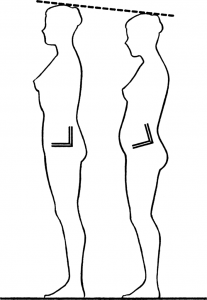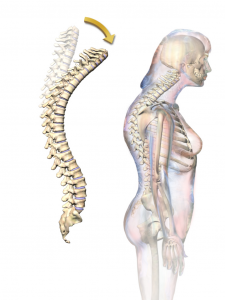
Sitting is a part of everyone’s daily life, whether you are sitting in a lecture for school or sitting in an office for work, an individual is bound to sit down at some point during their day. This does not necessarily mean it is a bad thing to be sitting everyday. However, prolonged periods of sitting can cause some serious postural issues that you may not even be aware of because your body has adapted it to be it’s natural state. Hence, sitting ergonomics are extremely important and it is crucial that you sit properly!
Postural Issues
There are two extremely common postural issues that an individual may have without even realizing it! You may have anterior pelvic tilt or kyphosis (rounded shoulders). It doesn’t happen overnight, but poor sitting ergonomics over the course of several years will definitely cause one of these issues to arise. In fact, poor posture is one of the most common causes of low back pain due to the muscular imbalances caused.
Anterior Pelvic Tilt (APT)

Left: Correct and normal pelvic posture Right: Anterior pelvic tilt
Anterior pelvic tilt (APT) directly arises from how you sit in your chair and for how long you sit in your chair. Sitting for too long causes the hip flexors to tighten and consequently weak abdominal muscles and weak glutes. The pelvic ends up tilting forward and a physically fit person that does not drink will have what is known as a “beer belly.” When the hip is tilted, your lower back arches and your stomach bulges outward. Having an arched lower back is not healthy for your spine and is a common cause for low back pain as the body is trying to compensate for the muscular imbalances by overworking the lower back muscles. When the hip tendons and muscles are tight, they become shortened and reduce the range of motion of how much it can extend. If you are a slow walker, you may have APT as the muscle tightness and imbalances have caused you to have a short range of motion when walking.
Kyphosis (Rounded Shoulders)
Kyphosis, also commonly known to be as having rounded shoulders or a “hunch back”, is another direct causation from poor sitting posture. However it is not caused by how you sit in your chair, but how you are leaning when at the desk.

Kyphosis (Rounded Shoulders)
If you are leaning or hunching over in order to work at a desk, this will cause kyphosis over a prolonged period of time. Kyphosis causes the chest muscles (pectoralis major and minor) to become shortened and tight and causes the upper back muscles to become weak and stretched. The muscular imbalance causes your head to protrude forward in order to compensate and your shoulders are rounded forward. The pectoralis major becomes overworked and tight which pulls the upper back and shoulder muscles forward. A good way to examine if you have kyphosis or not is to stand up straight and have your arms naturally leaning by your sides. Now, do your wrists turn inward towards your body or are they straight along your body? If your wrists are turned inwards, you might have kyphosis.
If you do have poor posture and desk ergonomics, it’s never too late to fix them! A short video created by the Wall Street Journal has experts explain how to ideally set up your desk to ensure maximum comfort and correct posture.
Sitting too long and having poor desk ergonomics causes a domino effect that leads to a variety of health issues. Although they may not be permanent, it definitely can cause discomfort in daily life.
From anterior pelvic tilt alone, it can cause back pain, limited walking motion, poor flexibility at the hamstrings, poor ankle mobility, and even poor balance.
Similarly, kyphosis causes neck pain, tight wrists which can cause wrist pain, slouching, and even slurred speech due to the body mechanics limiting air flow.
Make sure you sit right, otherwise you’ll remain tight!
Written by Jason Duong

